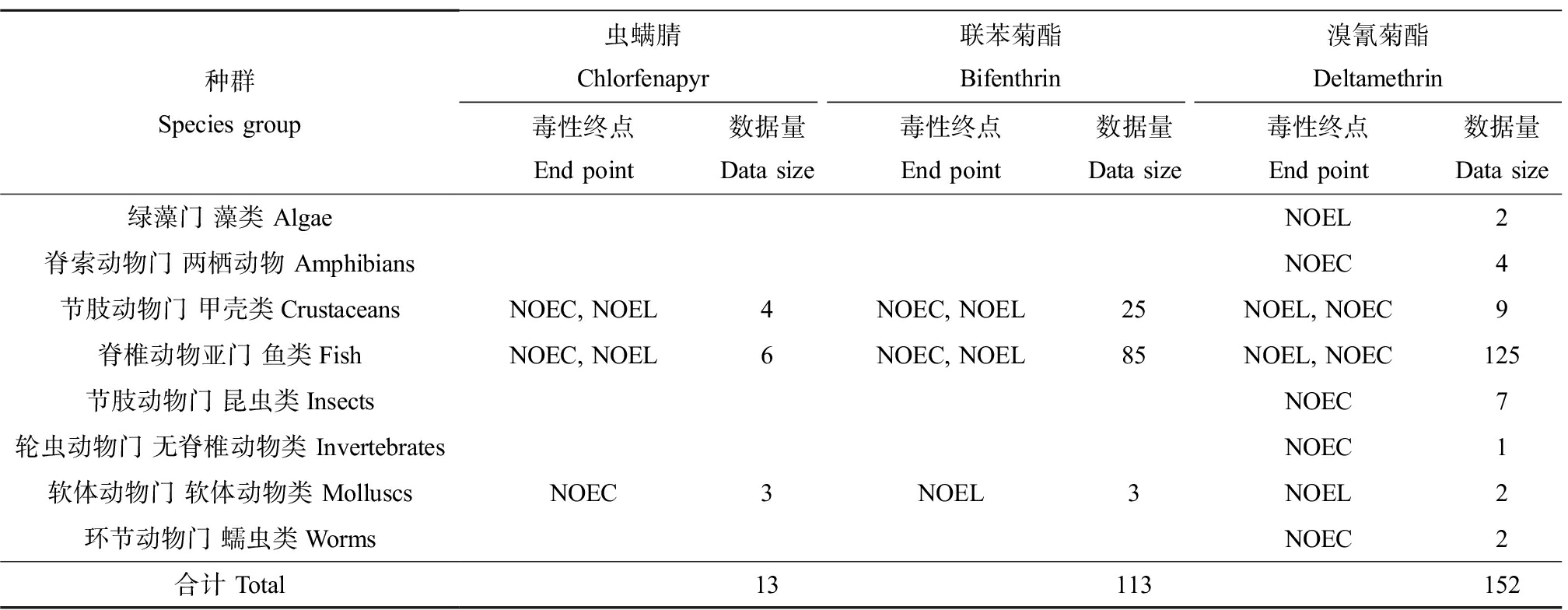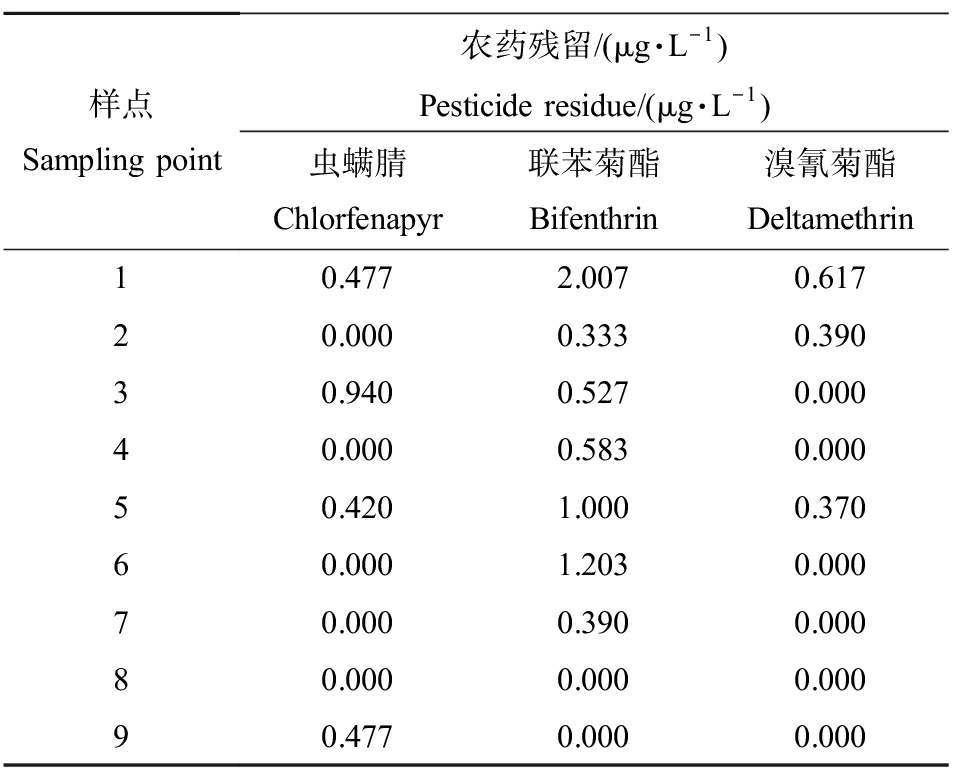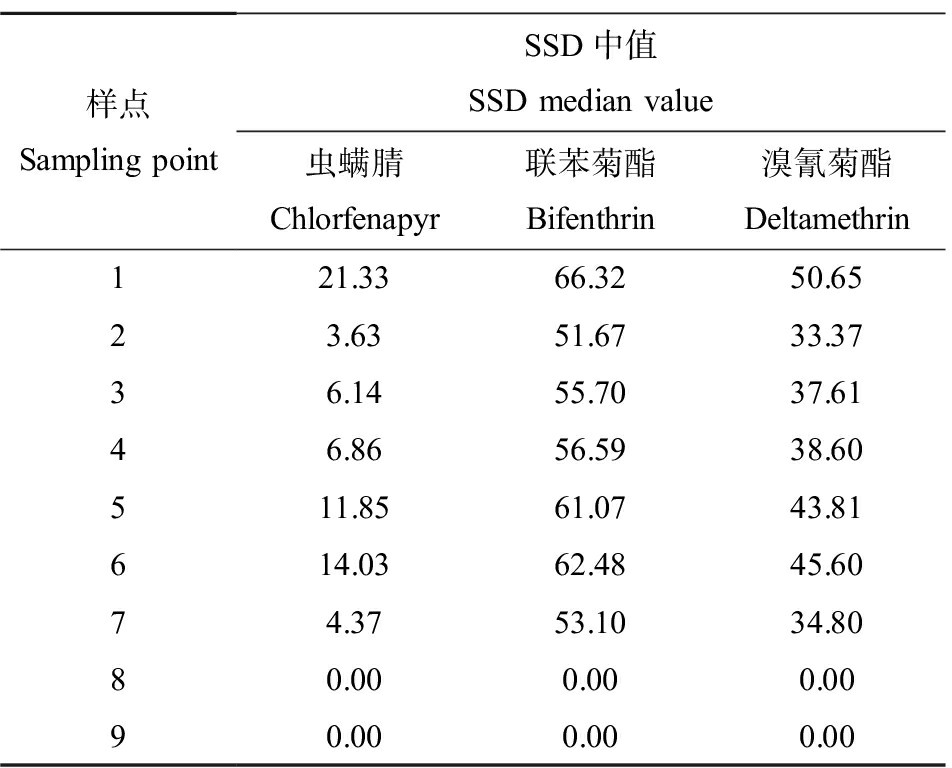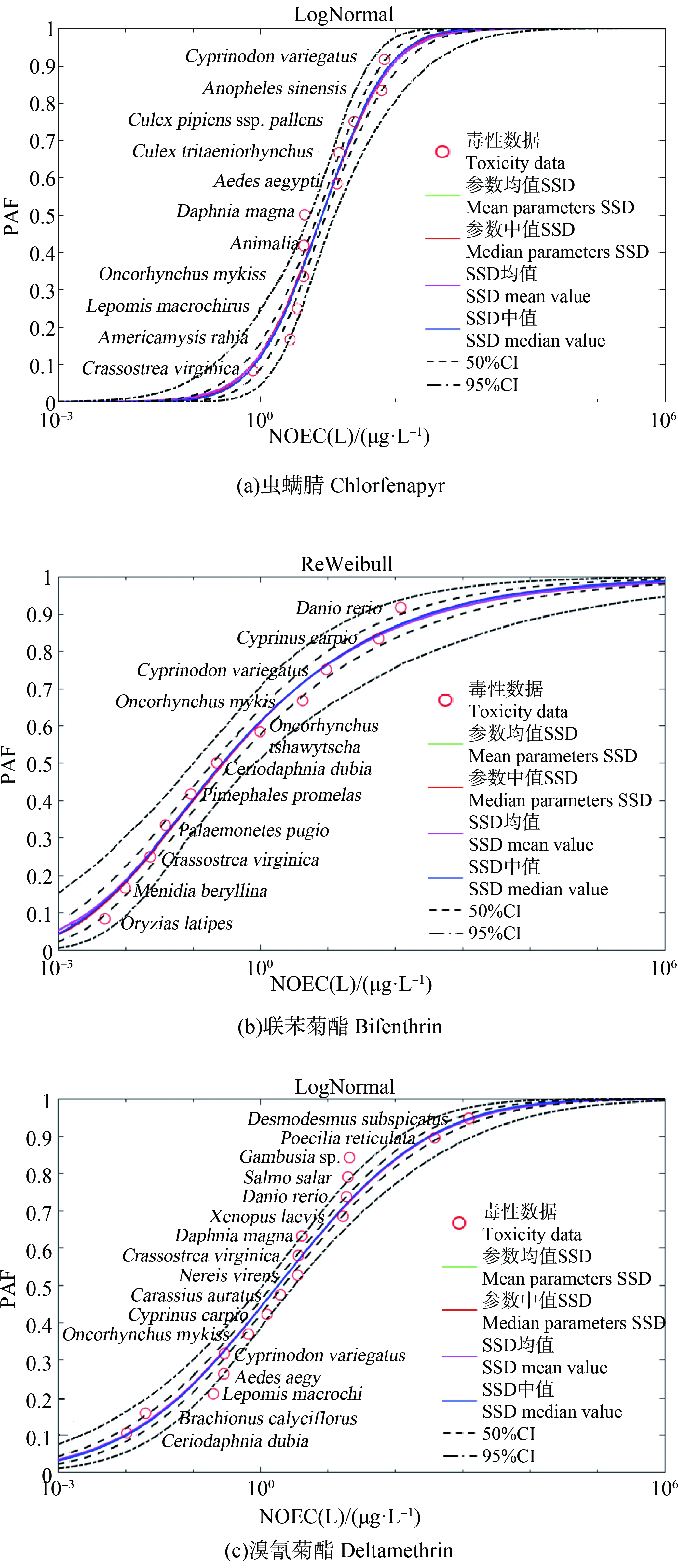农药是现代农业中非常重要的一种生产资料,是保证农业生产质量与数量的关键,但同时,过量的农药施用也会导致农药残留等污染问题[1]。随着作物产量的不断上升,农药的施用量也在不断增加,然而仅有30%左右停留在作物表面发挥功效,40%左右扩散到土壤和大气中,其余的30%左右因为淋失等原因随地表径流进入河流与湖泊当中,对流域中的生物造成一定的危害[2]。现今农药安全管理已日趋严格,农药的施用前提及标准的设定等均需考虑农药对于生态环境的危害程度[3-5]。而通过生态风险评价,可以定量分析评估某种农药对环境的影响程度,进而科学指导农药施用。
生态风险评价的方法众多,如风险商法(risk quotient, RQ)、概率风险法等[6-7]。本研究引入物种敏感度分布法(species sensitivity distribution, SSD)来评估研究区域的生态风险值。物种敏感度分布法是由Kooijman在1987年提出,其原理为在复杂的生态系统中,不同种属、不同门类的生物因为生理构造、地理分布等各种差异使得其对农药残留物的敏感程度各有不同且服从一定的概率分布,因此,通过这种概率分布函数来表达各生物物种对农药残留物的敏感度差异,即为物种敏感度分布法[8]。SSD方法相较于其他生态风险评价方法,可以有效地结合环境现实性较低的、缺乏生态性的单一物种在实验室内短期试验得出的毒理学数据,通常采用不同的毒性终点以表征某物种对某毒性物质的敏感度、耐受度等性状,其效应终点有急性数据如半数致死浓度(median lethal concentration, LC50)、半数效应浓度(median effect concentration, EC50),慢性数据如最大无观察效应浓度(no observed effect concentration, NOEC)以及最大无观察效应剂量(no observed effect level, NOEL),通过将这些效应终点的数据结果外推到生物群落或整个生态系统来进行风险评价[9-10]。
虫螨腈(chlorfenapyr)、联苯菊酯(bifenthrin)和溴氰菊酯(deltamethrin)等都是茶业生产中常见的杀虫剂,对应防治茶尺蠖、假眼小绿叶蝉和茶橙瘿螨虫害[11-13],成效显著,但同时,过量的施用也会导致杀虫剂迁移至周边土壤、水体甚至空气中;而土壤、水体及空气中的残留在进入生物体后会通过生物富集作用影响整个生物链,并最终产生对人类的膳食暴露风险。本研究通过SSD方法对绍兴茶园小流域进行虫螨腈、联苯菊酯和溴氰菊酯3类农药的生态风险评价,以期对周边茶园的农药减施增效、生态环境安全管理等方面提供一定参考依据和理论支持。
1 材料与方法(Materials and methods)
1.1 数据获取
研究区位于浙江省绍兴市越城区御茶村,该茶园种植规范,是我国典型的绿茶茶叶主产区。茶园每年3次机械化采摘,茶叶生长期间,根据实验地茶树虫害季节性发生规律[14-15],分别在6月上旬、6月中下旬和8月中旬各喷施1次,3次喷施的农药分别为联苯菊酯、溴氰菊酯和溴虫腈(俗称“虫螨腈”),对应防治茶尺蠖、假眼小绿叶蝉和茶橙瘿螨虫害,具体喷施的农药剂型为10%联苯菊酯乳油、2.5%溴氰菊酯乳油和24%虫螨腈乳油,施用剂量为联苯菊酯150 mL·hm-2、溴氰菊酯750 mL·hm-2和虫螨腈750 mL·hm-2。2017年8月,御茶村茶园农药喷施结束之后,于御茶村茶园内主要溪流采集水样,共布置9个采样点;1个月后,即2017年9月,选择御茶村茶园下游主要溪流及湖库采集水样,布置9个采样点,采样点分布如图1所示。所采集的表层水体样品,低温保存运输至实验室,进行3种农药残留的检测。样点覆盖研究区主要水系及交汇点。采样点描述如表1所示。

图1 研究区域及采样点分布
Fig. 1 Study area and sampling point distribution
本研究中用于构建SSD模型的毒理学数据均来源于美国环境保护局ECOTOX数据库(https://cfpub.epa.gov/ecotox/),该数据库有11 000多种化学物质对12 000多种水生生物、陆生动植物的83万多条毒理学数据[16-17]。在数据库中可根据毒性效果、毒性终点、受影响物种种类及测试介质等方面进行筛选;因为急性毒性数据的结果常低估化合物对环境的风险影响,更适用于应对偶发的环境污染事故或作为制定短期水质标准的参考,而慢性毒性数据更贴近于低浓度污染物在环境中长期暴露所造成的影响,因此本研究中主要选取NOEC和NOEL这2种慢性毒性终点数据,其结果更加契合农药残留物对环境的风险影响。选取鱼类、甲壳类和软体类等水生及两栖动物,藻类、苔藓和菌类等水生植物作为被影响物种构建茶园区域水环境毒理学数据库。
1.2 BITSSD软件及模型构建
本研究采用中国地质大学何伟与北京大学徐福留教授研发的水土环境农药污染物生态风险评价软件平台(简称BITSSD,著作权号2020SR1006185)进行计算,基于水土环境中农药的SSD曲线,利用软件中的模型数据库或本研究自建的农药SSD模型库计算农药生态风险概率[18]。该软件可同时构建Burr Ⅲ、Log Normal、Log Logistic、Weibull和ReWeibull这5种SSD模型,并采用偏差信息准则(DIC)、赤池信息量准则(AIC)和贝叶斯信息准则(BIC)综合评价确定最佳模型。通过随机初始值+非线性拟合的方式获得参数的先验分布相关系数;而后,利用马可夫链蒙托卡罗模拟(MCMC)的方式,采用3条链获取后验分布参数;最后利用后验分布参数对SSD模型参数的不确定性、SSD模型曲线的不确定性、SSD相关推导值的不确定性(如危害阈值(HCX)、潜在影响比例即风险值(PAF)等)进行估计,从而科学评估水土环境农药的生态风险[19-20]。其中,“HCX计算”子功能给出当x%的物种被影响时,农药达到的浓度,该值被称为危害阈值,一般用于预测无效应浓度和建立水质基准,通常选取5%物种危害浓度 (hazardous concentration for 5% the species, HC5)浓度,即群落中95%的物种不受污染物显著影响的最大浓度;“PAF计算”子功能给出了样点农药残留浓度对应的潜在物种影响比例,即生态风险值,是本软件最重要的输出数据,该数据用于生态风险评估[21-23]。
BITSSD软件中可通过自带的农药数据库建立SSD模型,但该数据库中农药数据有限,且物种选择不符合本次研究区的实际物种分布情况,因此本研究对从ECOTOX数据库获取的农药毒性数据进行归纳整理,选取适合的水生生物建立溴氰菊酯、联苯菊酯和虫螨腈的毒性数据库,物种选取需考虑的因素有[24]:(1)在本地生态系统或渔业生产中具有重要意义的代表性物种;(2)对污染物较敏感的物种;(3)各类生物在水生态系统中有不同的功能及作用,考虑来自不同营养级、不同生物类群的物种更具有代表性,如鱼类、浮游生物和底栖动物就可以表征一个复杂的水生态系统的结构特征和功能;(4)在商业上、娱乐上或者其他社会公众关注等方面较重要的物种[25-27]。在美国环境保护局ECOTOX数据库网站搜索页面中,根据研究要求,确定各类参数,如实验介质为水,毒性终点为NOEC、NOEL,受试物种为水生动植物,搜索并下载。搜索结果中,虫螨腈数据27条,联苯菊酯数据223条,溴氰菊酯数据208条。其中包含所有自然场地、人工场地及实验室测试的国际标准测试物种以及美国境内受威胁、濒危和入侵物种等[28-29]。本研究中研究区域属于我国东部太湖流域内,美国境内的标志性物种并不适用于此次研究,因此需对已下载的毒性数据进行二次筛选,去掉不适用于本研究的毒性数据,同时当同一物种有多个可用数据时,取几何平均值。
表1 采样点位置信息及描述
Table 1 The location of sampling point and description

样点Sampling point经度Longitude纬度Latitude海拔/mAltitude/m样点描述Sample description2017年8月采样点Sampling site in August 20171120°41'57.484"29°56'14.359"35.38园区水溪 Stream in plantation2120°42'1.375"29°56'12.330"33.54园区水溪 Stream in plantation3120°42'19.501"29°55'54.930"60.16园区水溪 Stream in plantation4120°42'15.725"29°55'45.757"71.63园区水溪 Stream in plantation5120°42'1.163"29°55'51.164"37.77园区水溪 Stream in plantation6120°42'15.249"29°56'10.036"41.45园区水溪 Stream in plantation7120°42'30.485"29°56'11.065"47.19园区水溪 Stream in plantation8120°42'5.576"29°55'26.128"76.45园区水溪 Stream in plantation9120°41'37.547"29°55'57.212"25.32园区水溪 Stream in plantation2017年9月采样点Sampling site in September 201710120°41'58.477"29°56'11.932"29.87园区外水溪 Stream outside the plantation11120°40'12.399"29°54'36.788"56.32园区外水溪 Stream outside the plantation12120°38'30.451"29°53'43.929"24.59园区外水溪 Stream outside the plantation13120°36'59.191"29°52'19.236"57.19平水江水库大坝出水口 The outlet of the dam of Pingshuijiang Reservoir14120°36'0.724"29°51'23.508"63.78水库南口 South entrance of the reservoir15120°36'51.004"29°47'36.506"102.42园区外水溪 Stream outside the plantation16120°39'32.076"29°44'17.091"85.97园区外水溪 Stream outside the plantation17120°39'11.791"29°42'29.552"158.7园区外水溪 Stream outside the plantation18120°38'59.931"29°41'39.724"253.1园区外池塘 Stream outside the plantation
结合以上各因素、中国本土敏感淡水水生生物推荐名录及ECOTOX数据库中的慢性毒性终点数据,最终收集到各农药毒性数据量为虫螨腈13条,联苯菊酯113条,溴氰菊酯152条,如表2所示。选取的物种主要包括:鲤鱼(Cyprinus carpio)、鲫鱼(Carassius auratus)、大型蚤(Daphnia magna)、模糊网纹蚤(Ceriodaphnia dubia)、摇蚊(Aedes aegypti)、萼花臂尾轮虫(Brachionus calyciflorus)、牡蛎(Crassostrea virginica)和绿藻(Desmodesmus subspicatus)。
1.3 水样农药检测与分析
于分液漏斗中加入100 mL水样,放入20 mL的二氯甲烷作为提取剂,分3次萃取,待样品液体分层后将下层液体转移至烧瓶中,如此反复进行3次,合并提取液并进行浓缩。采用旋转蒸发法浓缩至1~2 mL,再用氮吹法浓缩至干,向浓缩瓶中加丙酮约2 mL,上机检测[30]。所用仪器为气相色谱三重四极杆串联质谱联用仪(美国ThermoScientific,TSQ 9000)。色谱柱为HP-5 ms弹性石英毛细管柱,30 m×0.25 mm×0.25 μm。色谱升温程序:初始温度80 ℃,保持1 min;以40 ℃·min-1的速度升至160 ℃;再以5 ℃·min-1的速度升至200 ℃,保持5 min;以8 ℃·min-1升至240 ℃;再以5 ℃·min-1升至290 ℃,保持3 min;3 ℃·min-1升至300 ℃,保持3 min。进样口温度为250 ℃;接口温度为270 ℃;载气为高纯氮气(纯度≥99.999%);载气流速为1 mL·min-1;进样器模式为不分流进样;进样量为1 μL。质谱条件:电离方式为电子轰击离子源;离子源温度为230 ℃;电离能量为70 eV;四级杆温度为150 ℃;溶剂延迟时间为3.5 min;碰撞气为氮气,载气为氦气。
采用加标回收法来确定方法的准确度,在水样中加入相当于2、5和50 μg·mL-1水平的3种农药的标准溶液,并用上述气相色谱-质谱条件进行分析测定,得出虫螨腈、联苯菊酯和溴氰菊酯在水样中的回收率范围分别在95.00%~117.00%、98.00%~115.00%和97.00%~113.00%之间。
利用BITSSD软件的ECOTOX数据提取及归纳功能,导入选取好的各农药毒性数据表格文件,生成按照物种归类好的毒性数据。按照软件要求,依次导入3种农药归类好的毒性数据和暴露数据,暴露数据即环境实测或模型预测的农药残留浓度,在本研究中采用茶园实测的农药喷施8 d后残留浓度,进行整理后导入软件中。MCMC采样设置均为默认,即采样500次、移除200次和间隔10次。设置完成后即可进行5种SSD曲线的拟合计算。
表2 收集农药毒性数据量
Table 2 Collected pesticide toxicity data

种群Species group虫螨腈Chlorfenapyr联苯菊酯Bifenthrin溴氰菊酯Deltamethrin毒性终点End point数据量Data size毒性终点End point数据量Data size毒性终点End point数据量Data size绿藻门 藻类 AlgaeNOEL2脊索动物门 两栖动物 AmphibiansNOEC4节肢动物门 甲壳类CrustaceansNOEC, NOEL4NOEC, NOEL25NOEL, NOEC9脊椎动物亚门 鱼类FishNOEC, NOEL6NOEC, NOEL85NOEL, NOEC125节肢动物门 昆虫类InsectsNOEC7轮虫动物门 无脊椎动物类 InvertebratesNOEC1软体动物门 软体动物类 MolluscsNOEC3NOEL3NOEL2环节动物门 蠕虫类WormsNOEC2合计 Total13113152
注:NOEC为无观察效应浓度,NOEL为无观察效应剂量。
Note: NOEC stands for no observed effect concentration; NOEL stands for no observed effect level.
2 结果(Results)
2.1 SSD模型拟合曲线
将3种农药的毒性数据导入软件并计算后,得出各自5种SSD模型,根据模型优劣判定参数DIC、AIC和BIC的均值大小,选择最优SSD模型。其中虫螨腈的最优模型为Log Normal模型,联苯菊酯为ReWeibull模型,溴氰菊酯为Log Normal模型,各拟合曲线如图2所示。
2.2 危害阈值及生态风险
根据软件计算输出的数据,得到虫螨腈、联苯菊酯和溴氰菊酯的HC5值和PAF值,选用SSD中值和SSD 95%置信区间(confidence interval)数据,结果如图3所示,水环境下物种对联苯菊酯和溴氰菊酯较为敏感,生态风险阈值HC5值均为0.001 μg·L-1,即保护该水环境中95%的物种,联苯菊酯和溴氰菊酯的浓度需<0.001 μg·L-1。物种对虫螨腈的敏感性相对较差,HC5值为0.4 μg·L-1。
PAF计算值受暴露数据及危害阈值的影响,体现的是采样点处农药残留对该环境中物种的影响比例。根据2017年8月御茶村园区内水溪采样点农药残留数据及PAF计算SSD中值结果可知,9个采样点中,虫螨腈残留量最高影响22%的物种,溴氰菊酯残留量最高影响50%物种,联苯菊酯最高影响66%的物种;1个月后,御茶村下游水溪和水库中农药残留全部为未检出,据此可以判断茶园流域内农药残留带来的生态风险较低。表3和表4分别为2017年8月采样点农药残留数据和3种农药对物种的影响占比。
3 讨论(Discussion)
3.1 不同物种对农药的敏感性
从SSD模型曲线可看出,在水环境下,不同营养级的物种对农药存在不同的敏感度,无脊椎动物和节肢动物对于农药的敏感度高于鱼类;营养级越高的物种对于农药的敏感度越低。刘亚莉等[31]评价敌敌畏对淡水水生生物的生态风险时得出无脊椎动物在敌敌畏低浓度范围内敏感度高于脊椎动物,甲壳类、昆虫和蜘蛛类动物敏感度相均较高,鱼类敏感度较低。农药随着生物链向上传递,在高营养级物种体内存在富集风险,鱼类作为研究区内的高营养级生物,又同时被更高营养级的人类等捕食,对整体生态系统有着巨大的影响,本研究中鱼类物种选用鲤鱼和鲫鱼建立毒性数据库,数据表明2种鱼类对3种农药的敏感度较低,说明这3种农药施用于该区域不会对研究区甚至整体生态系统有更深的影响。
3.2 物种选择对SSD模型的影响
本研究SSD模型构建过程中,存在一些因素影响最终的数据结果,如在生物物种的选择上,美国ECOTOX数据库虽然涵盖物种较为丰富但缺少中国本土物种的毒性数据,且各条数据研究条件不同会导致数据结果差别较大;藻类物种的数据较少,影响藻类物种的敏感度数据以及最终的拟合效果[32-33];在毒性数据库建立过程中,ECOTOX数据库中虫螨腈的毒性数据条目较少,物种的选取范围较小,经过筛选后仅剩数十条可用的毒性数据,相比联苯菊酯和溴氰菊酯上百条的数据来说,虫螨腈的毒性数据库不够完善,物种种类较少,也会导致对物种敏感度及生态风险的模拟产生一定的偏差。目前,SSD方法对毒理数据的选择暂时没有统一的规定,经济合作与发展组织(OECD)推荐最少数据为5个,而美国环境保护局(US EPA)推荐至少涉及3个门属8个群种。张家玮等[34]在评价中国长三角区地表水壬基酚生态风险时基于通用敏感物种和中国本地敏感物种分别构建SSD曲线,得出通用敏感物种慢性毒性HC5=5.9 μg·L-1,本地敏感物种慢性毒性HC5=1.56 μg·L-1,差异近4倍。以上研究结果均表明基于本地敏感物种构建的SSD模型能更好地表征当地的生态风险状况。因此,虽然本研究只选取了8种本地物种,但它们对研究区内的农药敏感度具有较好的代表性,以此建立SSD模型并开展生态风险评价具有合理性。
表3 2017年8月采样点农药残留
Table 3 Pesticides residues at the sampling
sites in August 2017

样点Sampling point农药残留/(μg·L-1)Pesticide residue/(μg·L-1)虫螨腈Chlorfenapyr联苯菊酯Bifenthrin溴氰菊酯Deltamethrin10.4772.0070.61720.0000.3330.39030.9400.5270.00040.0000.5830.00050.4201.0000.37060.0001.2030.00070.0000.3900.00080.0000.0000.00090.4770.0000.000
表4 3种农药影响物种比例
Table 4 Proportion of species affected
by three pesticides (%)

样点Sampling pointSSD中值SSD median value虫螨腈Chlorfenapyr联苯菊酯Bifenthrin溴氰菊酯Deltamethrin121.3366.3250.6523.6351.6733.3736.1455.7037.6146.8656.5938.60511.8561.0743.81614.0362.4845.6074.3753.1034.8080.000.000.0090.000.000.00

图2 3种农药的物种敏感度分布(SSD)曲线
注:PAF表示潜在影响比例,即风险值;CI表示置信区间;NOEC为无观察效应浓度,NOEL为无观察效应剂量;
LogNormal、ReWeibull为物种敏感度分布曲线模型。
Fig. 2 Species sensitivity distribution (SSD) curves of three pesticides
Note: PAF stands for potential affected fraction; CI stands for confidence interval; NOEC stands for no observed effect concentration,
NOEL stands for no observed effect level; LogNormal and ReWeibull are species sensitivity distribution curves model.

图3 3种农药的危害阈值曲线
注:CI表示置信区间。
Fig. 3 Hazard threshold curves of three pesticides
Note: CI stands for confidence interval.
3.3 SSD模型选择对生态风险的影响
SSD是一种基于单物种测试将预计的风险通过统计模型以概率的方式表达外推出来的方法,由于SSD没有特定的分布规律,不同学者在应用中基于经验提出了不同的SSD分布模型。王铜等[35]发现在污水处理厂同一处理工艺组合下,采用Burr Ⅲ分布和Log Logistic分布模型得到的拟合数据可相差3倍~9倍;李晓阳等[36]在湿地生态保护区相同水质条件下,根据Weibull模型和Burr Ⅲ模型计算得到的拟合数据相差2倍。为了尽可能减少系统偏差,在开展生态风险研究时,不能仅依靠经验或参照前人的研究来选择模型,需要进行相关评价选择出最优拟合模型。本研究中采用的BITSSD软件平台,可快速简便地构建出5种常见的SSD模型,并通过DIC、AIC和BIC这3种相关参数进行综合评价以确定最佳模型,有效降低了出现误差的可能性,提高了SSD方法评估的准确性和可靠性。
综上所述,可以得出:
(1)根据2017年8月采样点数据(图4),茶园内水溪中3类农药,联苯菊酯在7个采样点中都有测出,且残留量相对较高,最高达到2.0 μg·L-1。考虑到联苯菊酯的HC5值较小,即该水环境中联苯菊酯的物种敏感度较高,因此联苯菊酯为浙江茶园小流域内生态风险的主要贡献者;虫螨腈和溴氰菊酯在各采样点的残留量检出较少,个别采样点未检出,但因为该环境中物种对溴氰菊酯较为敏感,其影响的物种比例依然偏高,存在潜在风险;虫螨腈对该环境中物种的风险处于低水平。残留农药通常经过降雨从植物表面及土壤中冲刷到水中,多半属于水溶性,半衰期较短,多挥发至空气中或随径流进入下游土壤[37]。本研究中茶园下游流域水样中均未检测出3种农药,说明这3种农药施用对茶园流域的生态风险较低。

图4 采样点3种农药残留
Fig. 4 Residues of three pesticides at the sampling site
(2)虫螨腈、联苯菊酯和溴氰菊酯3种常见的农药在喷施初期其残留对浙江绍兴茶园内物种存在一定的威胁,虫螨腈最高可影响水环境中22%的物种、溴氰菊酯最高影响50%的物种,联苯菊酯最高影响66%的物种。根据BITSSD模型模拟结果,联苯菊酯和溴氰菊酯在浓度<0.001 μg·L-1、虫螨腈浓度<0.4 μg·L-1时,可保护茶园流域环境中95%的物种不受影响,但在喷施近1个月之后,茶园下游流域水体未测出3种农药的残留,说明农药施用对绍兴茶园小流域的物种影响较小,其生态风险可控。
致谢:中国热带农业科学院吕岱竹研究员提供了3种农药的测定服务,特此致谢!
通讯作者简介:周建利(1971—),男,博士,副教授,主要研究方向为重金属污染土壤环境修复。
共同通讯作者简介:韦朝阳(1965—),男,博士,研究员,主要研究方向为重金属环境健康效应及重金属污染修复。
[1] 赵李娜, 赖子尼, 张威振, 等. 珠江河网水产品中菊酯类农药残留调查及健康风险评价[J]. 生态毒理学报, 2014, 9(3): 437-444
Zhao L N, Lai Z N, Zhang W Z, et al. Residual levels and health risk assessment of pyrethroid pesticides in aquatic products of the Pearl River Delta [J]. Asian Journal of Ecotoxicology, 2014, 9(3): 437-444 (in Chinese)
[2] 赵玲, 滕应, 骆永明. 中国农田土壤农药污染现状和防控对策[J]. 土壤, 2017, 49(3): 417-427
Zhao L, Teng Y, Luo Y M. Present pollution status and control strategy of pesticides in agricultural soils in China: A review [J]. Soils, 2017, 49(3): 417-427 (in Chinese)
[3] 马畅, 刘新刚, 吴小虎, 等. 农田土壤中的农药残留对农产品安全的影响研究进展[J]. 植物保护, 2020, 46(2): 6-11
Ma C, Liu X G, Wu X H, et al. Research progress in the impact of pesticide residues in farmland soil on agricultural product safety [J]. Plant Protection, 2020, 46(2): 6-11 (in Chinese)
[4] 魏启文, 陶传江, 宋稳成, 等. 农药风险评估及其现状与对策研究[J]. 农产品质量与安全, 2010(2): 38-42
[5] 雷昌文, 曹莹, 周腾耀, 等. 太湖水体中5种有机磷农药混合物生态风险评价[J]. 生态毒理学报, 2013, 8(6): 937-944
Lei C W, Cao Y, Zhou T Y, et al. Ecological risk assessment of five organophosphorus pesticides mixture in Taihu Lake [J]. Asian Journal of Ecotoxicology, 2013, 8(6): 937-944 (in Chinese)
[6] Maltby L, Blake N, Brock T C, et al. Insecticide species sensitivity distributions: Importance of test species selection and relevance to aquatic ecosystems [J]. Environmental Toxicology and Chemistry, 2005, 24(2): 379-388
[7] 周怡彤, 李清雪, 王斌, 等. 太湖流域西北部地表水中农药的污染特征及生态风险评价[J]. 生态毒理学报, 2020, 15(3): 171-183
Zhou Y T, Li Q X, Wang B, et al. Distribution and ecotoxicological risk assessment of pesticides in surface water of the northwest of Taihu Lake Basin [J]. Asian Journal of Ecotoxicology, 2020, 15(3): 171-183 (in Chinese)
[8] Fox D R, Dam R A V, Fisher R, et al. Recent developments in species sensitivity distribution modeling [J]. Environmental Toxicology and Chemistry, 2021, 40(2): 293-308
[9] van Wijngaarden R P A, Arts G H P, Belgers J D M, et al. The species sensitivity distribution approach compared to a microcosm study: A case study with the fungicide fluazinam [J]. Ecotoxicology and Environmental Safety, 2010, 73(2): 109-122
[10] Sorgog K, Kamo M. Quantifying the precision of ecological risk: Conventional assessment factor method vs. species sensitivity distribution method [J]. Ecotoxicology and Environmental Safety, 2019, 183: 109494
[11] 赵之德, 李海涛, 梁涛. 联苯菊酯等3种杀虫剂在茶园茶叶、土壤及降雨径流中的残留[J]. 中国生态农业学报(中英文), 2019, 27(8): 1265-1274
Zhao Z D, Li H T, Liang T. Residues of three insecticides in tea leaves, soil and rainwater runoff [J]. Chinese Journal of Eco-Agriculture, 2019, 27(8): 1265-1274 (in Chinese)
[12] Yang J, Luo F J, Zhou L, et al. Residue reduction and risk evaluation of chlorfenapyr residue in tea planting, tea processing, and tea brewing [J]. Science of the Total Environment, 2020, 738: 139613
[13] 赵晨, 彭书传, 陈天虎, 等. 巢湖流域和太湖流域沉积物中苄氯菊酯和高效氰戊菊酯的生态风险评价[J]. 环境科学学报, 2016, 36(3): 1080-1091
Zhao C, Peng S C, Chen T H, et al. Ecological risk assessment of sediment-associated permethrin and esfenvalerate in Chaohu Lake and Taihu Lake watersheds [J]. Acta Scientiae Circumstantiae, 2016, 36(3): 1080-1091 (in Chinese)
[14] 杨浩瑜, 刘惠见, 张乃明, 等. 化肥减施处理对茶园土壤养分及茶叶品质的影响[J]. 南方农业学报, 2020, 51(4): 887-896
Yang H Y, Liu H J, Zhang N M, et al. Effects of different fertilization application reduction methods on tea garden soil nutrient and tea quality [J]. Journal of Southern Agriculture, 2020, 51(4): 887-896 (in Chinese)
[15] 谢邵文, 杨芬, 冯含笑, 等. 中国化肥农药施用总体特征及减施效果分析[J]. 环境污染与防治, 2019, 41(4): 490-495
Xie S W, Yang F, Feng H X, et al. General characteristics of the chemical fertilizers and pesticides use and the analysis of use reduction effect in China [J]. Environmental Pollution & Control, 2019, 41(4): 490-495 (in Chinese)
[16] 吴爱明. 我国水质基准数据整编技术方法初步研究——以美国生态毒性数据整编为例[D]. 昆明: 昆明理工大学, 2017: 35-38
Wu A M. Preliminary research on technical method for compilation for water quality criteria in China—Using the compilation for US ecotoxicology data as a case [D]. Kunming: Kunming University of Science and Technology, 2017: 35-38 (in Chinese)
[17] 吴爱明, 赵晓丽, 冯宇, 等. 美国生态毒理数据库(ECOTOX)对中国数据库构建的启示[J]. 环境科学研究, 2017, 30(4): 636-644
Wu A M, Zhao X L, Feng Y, et al. The enlightenment of the ecotoxicology knowledgebase (ECOTOX) for its establishment in China [J]. Research of Environmental Sciences, 2017, 30(4): 636-644 (in Chinese)
[18] He W, Kong X Z, Qin N, et al. Combining species sensitivity distribution (SSD) model and thermodynamic index (exergy) for system-level ecological risk assessment of contaminates in aquatic ecosystems [J]. Environment International, 2019, 133(Pt B): 105275
[19] Pérez D J, Iturburu F G, Calderon G, et al. Ecological risk assessment of current-use pesticides and biocides in soils, sediments and surface water of a mixed land-use basin of the Pampas region, Argentina [J]. Chemosphere, 2021, 263: 128061
[20] Guarda P M, Pontes A M S, Domiciano R S, et al. Assessment of ecological risk and environmental behavior of pesticides in environmental compartments of the Formoso River in Tocantins, Brazil [J]. Archives of Environmental Contamination and Toxicology, 2020, 79(4): 524-536
[21] 林荣华, 姜辉, 王猛, 等. 物种敏感度分布(SSD)方法在农药环境风险评估中的应用[J]. 生态毒理学报, 2017, 12(4): 110-118
Lin R H, Jiang H, Wang M, et al. Application of species sensitivity distribution (SSD) to the environmental risk assessment of pesticides [J]. Asian Journal of Ecotoxicology, 2017, 12(4): 110-118 (in Chinese)
[22] 张晓惠, 袁雪竹, 陈红, 等. 基于SSD法的持久性污染物水生态风险阈值研究[J]. 生态科学, 2016, 35(3): 85-91
Zhang X H, Yuan X Z, Chen H, et al. The aquatic ecological risk thresholds of persistent organic pollutants based on species sensitivity distribution [J]. Ecological Science, 2016, 35(3): 85-91 (in Chinese)
[23] 王婷, 张红, 史雅娟, 等. 我国硒淡水水生生物水质基准值推导[J]. 环境科学学报, 2020, 40(4): 1278-1285
Wang T, Zhang H, Shi Y J, et al. Derivation of freshwater quality criteria of selenium for protection of aquatic organisms in China [J]. Acta Scientiae Circumstantiae, 2020, 40(4): 1278-1285 (in Chinese)
[24] 李会仙, 张瑞卿, 吴丰昌, 等. 中美淡水生物区系中汞物种敏感度分布比较[J]. 环境科学学报, 2012, 32(5): 1183-1191
Li H X, Zhang R Q, Wu F C, et al. Comparison of mercury species sensitivity distributions of freshwater biota in China and the United States [J]. Acta Scientiae Circumstantiae, 2012, 32(5): 1183-1191 (in Chinese)
[25] 苏海磊, 吴丰昌, 李会仙, 等. 太湖生物区系研究及与北美五大湖的比较[J]. 环境科学研究, 2011, 24(12): 1346-1354
Su H L, Wu F C, Li H X, et al. Aquatic biota of Taihu Lake and comparison with those of the North American great lakes [J]. Research of Environmental Sciences, 2011, 24(12): 1346-1354 (in Chinese)
[26] 中华人民共和国环境保护部. 淡水水生生物水质基准制定技术指南: HJ 831—2017[S]. 北京: 中国环境出版社, 2017
[27] 刘鸿亮. 湖泊富营养化调查规范[M]. 北京: 中国环境科学出版社, 1987: 138-152
[28] Thunnissen N W, Lautz L S, van Schaik T W G, et al. Ecological risks of imidacloprid to aquatic species in the Netherlands: Measured and estimated concentrations compared to species sensitivity distributions [J]. Chemosphere, 2020, 254: 126604
[29] 肖鹏飞, 林晓雅, 刘毅华, 等. 基于物种敏感性分布法的毒死蜱对稻田生态系统生态风险评价[J]. 生态毒理学报, 2017, 12(3): 398-407
Xiao P F, Lin X Y, Liu Y H, et al. Application of species sensitivity distribution in aquatic ecological risk assessment of chlopyrifos for paddy ecosystem [J]. Asian Journal of Ecotoxicology, 2017, 12(3): 398-407 (in Chinese)
[30] 江阳, 王艳, 魏红, 等. 高效液相色谱-串联质谱法同时测定饮用水中的13种农药残留[J]. 中国卫生检验杂志, 2016, 26(2): 184-188
Jiang Y, Wang Y, Wei H, et al. Determination of thirteen pesticides in drinking water by HPLC- MS/MS [J]. Chinese Journal of Health Laboratory Technology, 2016, 26(2): 184-188 (in Chinese)
[31] 刘亚莉, 谢玉为, 张效伟, 等. 应用物种敏感性分布评价敌敌畏对淡水生物的生态风险[J]. 生态毒理学报, 2016, 11(2): 531-538
Liu Y L, Xie Y W, Zhang X W, et al. Assessing ecological risks of dichlorvos to freshwater organisms by species sensitivity distribution [J]. Asian Journal of Ecotoxicology, 2016, 11(2): 531-538 (in Chinese)
[32] Lee M S, Lee J H, An Y J, et al. Development of water quality criteria for arsenic to protect aquatic life based on species sensitivity distribution [J]. Ecotoxicology and Environmental Safety, 2020, 189: 109933
[33] 陈波宇, 郑斯瑞, 牛希成, 等. 水生生物对三唑磷的物种敏感度分布研究[J]. 环境科学, 2011, 32(4): 1101-1107
Chen B Y, Zheng S R, Niu X C, et al. Species sensitive distribution for aquatic biota exposed to triazophos [J]. Environmental Science, 2011, 32(4): 1101-1107 (in Chinese)
[34] 张家玮, 齐观景, 赵昊铎, 等. 基于物种敏感性分布评价长三角地区地表水壬基酚生态风险[J]. 生态毒理学报, 2020, 15(3): 134-148
Zhang J W, Qi G J, Zhao H D, et al. Ecological risk assessment of nonylphenol in surface waters of the Yangtze River Delta based on species sensitivity distribution model [J]. Asian Journal of Ecotoxicology, 2020, 15(3): 134-148 (in Chinese)
[35] 王铜, 孙傅, 曾思育, 等. 北京市污水处理厂出水中雌二醇的概率生态风险评价[J]. 生态毒理学报, 2015, 10(1): 271-280
Wang T, Sun F, Zeng S Y, et al. Probabilistic ecological risk assessment of estradiol in the effluents of wastewater treatment plants in Beijing [J]. Asian Journal of Ecotoxicology, 2015, 10(1): 271-280 (in Chinese)
[36] 李晓阳, 孙傅, 曾思育, 等. 某湿地生态保护区水体中铜的生态风险评价及管理限值研究[J]. 生态毒理学报, 2014, 9(4): 647-656
Li X Y, Sun F, Zeng S Y, et al. Ecological risk assessment and derivation of a guideline value for copper in the water of a wetland reserve [J]. Asian Journal of Ecotoxicology, 2014, 9(4): 647-656 (in Chinese)
[37] Dowse R, Tang D D, Palmer C G, et al. Risk assessment using the species sensitivity distribution method: Data quality versus data quantity [J]. Environmental Toxicology and Chemistry, 2013, 32(6): 1360-1369